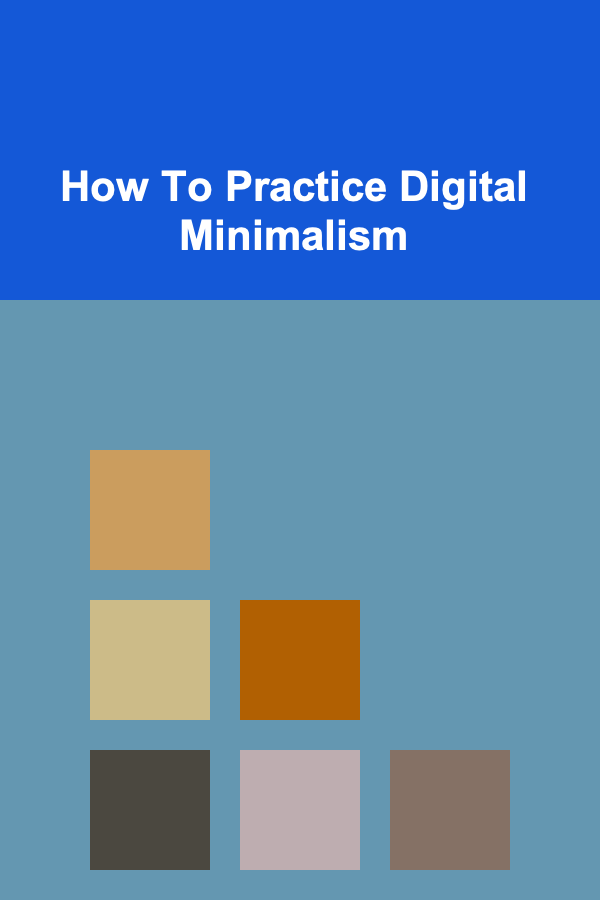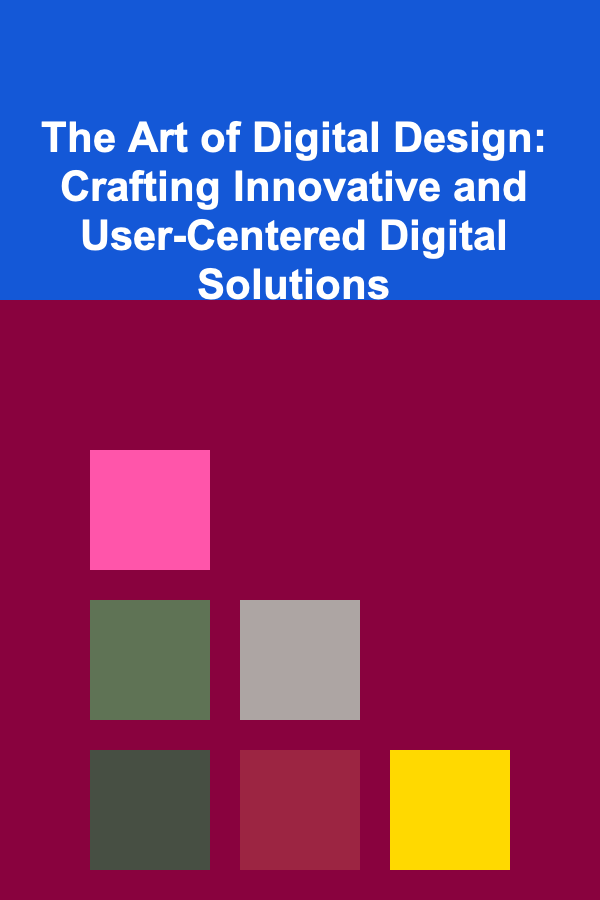
How To Practice Digital Minimalism
ebook include PDF & Audio bundle (Micro Guide)
$12.99$11.99
Limited Time Offer! Order within the next:

In an age dominated by constant connectivity, digital distractions, and an ever-growing array of apps, gadgets, and platforms, digital minimalism has emerged as a vital philosophy for reclaiming our attention and time. Digital minimalism isn't just about reducing screen time or deleting apps; it's about intentionally focusing on the digital tools that matter most to you and eliminating everything that doesn't serve a meaningful purpose. This practice involves making conscious decisions about how to engage with technology in a way that aligns with your values and goals.
In this article, we'll explore the concept of digital minimalism, its benefits, and how you can implement it in your life to lead a more focused, productive, and fulfilling existence.
What Is Digital Minimalism?
Digital minimalism is a mindset and lifestyle that encourages the intentional use of technology. It stems from the principles of minimalism, which advocate for simplifying and decluttering one's life by eliminating unnecessary possessions and distractions. When applied to technology, digital minimalism involves cutting out the digital clutter---be it apps, notifications, social media, or other digital distractions---and only using technology in ways that support your values and goals.
The idea isn't to shun technology completely, but rather to use it with greater intention. It's about being selective with the tools you use and learning to say no to digital distractions that waste your time and energy. In a world where we're constantly bombarded by information, social media updates, and digital noise, digital minimalism can help you regain control over how and when you engage with technology.
The Benefits of Digital Minimalism
Adopting digital minimalism offers a wide range of benefits. These go beyond simply reducing screen time and include improvements in mental health, productivity, and personal well-being.
1. Enhanced Focus and Productivity
One of the primary goals of digital minimalism is to eliminate distractions that interfere with your ability to focus on important tasks. By reducing the number of digital tools you use, you can increase your ability to concentrate on deep, meaningful work. Without constant notifications and the temptation of social media, you'll be able to engage in tasks that require more attention, which can lead to higher productivity and more satisfaction with your work.
2. Improved Mental Health
Technology, especially social media, can be a major contributor to stress, anxiety, and feelings of inadequacy. By practicing digital minimalism, you can reduce exposure to online comparisons, negative news, and the constant pressure to stay connected. This can lead to reduced feelings of anxiety, better emotional well-being, and a more balanced perspective on life. Fewer digital distractions also mean less time spent in a reactive state, allowing for more intentional moments of relaxation and mindfulness.
3. Better Time Management
Digital minimalism forces you to evaluate how you spend your time online and which activities contribute most to your goals. By removing time-wasting habits like endlessly scrolling through social media or checking email impulsively, you can reclaim hours that were previously lost to mindless digital consumption. Instead, you can focus on activities that are more enriching, like spending time with loved ones, engaging in hobbies, or pursuing personal growth.
4. Reconnection with the Real World
When you reduce your reliance on digital devices and social media, you create space for more meaningful connections with the people around you. Instead of getting lost in a digital world, you'll have the opportunity to engage more deeply with your surroundings, whether it's by reading a book, enjoying nature, or having face-to-face conversations. This reconnection with the real world can significantly enhance your quality of life and help restore balance in your life.
5. Stronger Relationships
Social media and digital communication can sometimes undermine authentic relationships. With constant notifications and distractions, it's easy to neglect real-world interactions. Digital minimalism encourages more intentional, in-person communication, fostering stronger and more meaningful relationships with those who matter most to you.
How to Practice Digital Minimalism
Digital minimalism is a personal practice, and how you implement it will depend on your own goals and lifestyle. However, there are several key steps you can take to begin living a more minimalist digital life.
1. Audit Your Digital Life
The first step to practicing digital minimalism is to conduct a digital audit. This involves taking stock of all the digital tools, apps, devices, and platforms you use. Consider the following:
- Apps: Which apps do you use most frequently? Which ones do you mindlessly check without much thought? Are there any apps that don't add value to your life?
- Social Media: How much time do you spend on social media? Do you enjoy it, or is it more of a habit? Are there platforms that contribute to negative emotions or unproductive behavior?
- Notifications: What kinds of notifications do you receive on a daily basis? Are they essential, or are they just distracting you from your work or personal life?
- Devices: How many devices do you use regularly? Do you need all of them, or could you reduce your reliance on certain gadgets?
Once you've completed your audit, you'll have a clearer understanding of the areas in which digital minimalism can benefit you.
2. Eliminate Digital Clutter
After conducting your audit, it's time to take action. Start by removing unnecessary digital tools that don't contribute to your well-being or productivity. This may include:
- Deleting apps: Remove apps that you rarely use or that contribute to mindless scrolling and distractions. For example, if you spend too much time on social media, consider deleting some apps or limiting your usage to specific times of the day.
- Unsubscribing from email lists: Unsubscribe from email newsletters and promotional emails that clutter your inbox. Only subscribe to the ones that provide value and align with your interests.
- Limiting notifications: Turn off non-essential notifications on your devices. Consider setting "Do Not Disturb" periods during which you are not interrupted by notifications.
The goal is to remove as much digital clutter as possible, so that you're only left with the digital tools and platforms that truly support your goals and values.
3. Set Clear Intentions for Your Digital Usage
Once you've eliminated the unnecessary digital distractions, set clear intentions for how you will use technology moving forward. Define specific goals for your digital life, and ensure that the tools you use are aligned with these objectives. For example:
- Work: If you're using technology to work, focus on tools that enhance your productivity and make tasks easier to complete. Avoid getting sidetracked by non-essential apps and websites.
- Social Media: If social media is part of your life, be intentional about the platforms you use and the people you follow. Consider how often you engage and whether the time spent on social media is contributing positively to your life.
- Leisure: If you use technology for leisure or entertainment, make sure it's enriching and not just a way to kill time. For instance, instead of mindlessly scrolling through YouTube, consider using a streaming service to watch educational documentaries or listening to podcasts that align with your interests.
By setting clear intentions, you can ensure that your use of digital tools aligns with your values and enhances your life rather than detracts from it.
4. Establish Boundaries with Technology
Digital minimalism also involves setting boundaries with technology. Here are a few tips to help you establish healthy digital boundaries:
- Create tech-free zones: Designate certain areas of your home or daily routine as tech-free zones. For example, you might choose to keep your bedroom free of screens or set aside specific times for tech-free activities like reading, exercising, or having meals with loved ones.
- Schedule digital detoxes: Consider scheduling regular digital detoxes, where you take a break from screens for a specific period. This could be as simple as taking a weekend off from social media or dedicating a day each week to focus on offline activities.
- Limit screen time: Use built-in tools on your devices to track and limit your screen time. Many phones and computers now offer screen time tracking features, allowing you to set limits on apps or websites that consume too much of your time.
5. Cultivate Offline Activities
To fill the space that digital minimalism creates, it's essential to cultivate offline activities that nourish your mind and body. This might include:
- Reading: Spend more time reading books, magazines, or articles that interest you. Choose physical books or e-books that don't require constant screen interaction.
- Exercise: Engage in physical activities that get you moving, such as walking, running, yoga, or weightlifting.
- Creative hobbies: Pursue hobbies like painting, cooking, gardening, or playing an instrument---anything that brings you joy and helps you connect with your surroundings.
By investing more time in offline activities, you'll find that you feel more fulfilled and less reliant on technology to provide entertainment or stimulation.
6. Reassess Regularly
Digital minimalism is a continuous process, and it's important to regularly reassess your digital habits. Periodically review the tools you're using, evaluate whether they still align with your goals, and make adjustments as necessary. Digital life is ever-evolving, and so should your approach to it.
Conclusion
Digital minimalism is about reclaiming your time, focus, and energy from the digital distractions that consume modern life. By eliminating digital clutter, setting clear intentions, and establishing boundaries with technology, you can create a more intentional and balanced digital life. The practice of digital minimalism is not about abandoning technology but using it more purposefully to enrich your life, improve your mental health, and focus on what truly matters. It's a journey toward greater mindfulness in the digital world---one step at a time.
Other Products

How to Create a Checklist for Planning a Successful Fundraising Event
Read More
How to Extend the Life of Your Coffee Maker
Read More
How to Soundproof Windows Without Replacing Them
Read More
How to Start a Home Budget with a Small Income
Read More
Saving Money on Home Meal Delivery Services: A Complete Guide
Read More